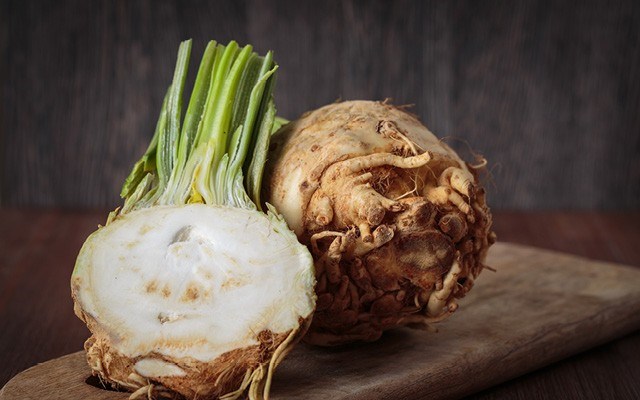Right now in Pemberton Valley, at the foot of Mount Currie and under the protective cover of North Arm Farm's greenhouse, thousands and thousands of celeriac plants are starting to grow. So don't get freaked out if you suddenly start seeing bunches of these knobbly, root vegetables around later this season.
Resembling fat, little gnarly spacecraft or alien pods, celeriac has got to be one of the weirdest looking veggies on the planet. But oh, does it taste good! And the Sturdys, who own North Arm Farm, have their fingers crossed. It's something of an experiment in this neck of the woods even though celeriac has been known since ancient times.
In The Odyssey, which is some 2,700 years old, Homer describes Hermes (Mercury in the Roman pantheon) seeing wild selinon, as the Greeks call it, growing at the entrance of Calypso's cave when he comes bounding around for a visit. So there's your first clue as to why this might be a challenge, at least from a gardener's or farmer's point of view — celeriac is native to the Mediterranean basin.
Another reason, one I might be able to help out with a bit here, is that other than professional chefs, few people living in this neck of the woods know what celeriac is, never mind how to pronounce it (it's se-ler-EE-ak) or use it in the kitchen. It's actually so off the radar it barely rates 300 words in Wikipedia. (Compare that to, say, tomatoes at more than 7,500 words!) But let's change all that, starting with the plant itself.
First off, celeriac is not actually celery root, despite the fact it's sometimes called that. And it's not celery, although it's in the same family and has a similar flavour. In fact, it isn't even a root.
The big bulb called celeriac you see on some produce shelves and soon at local farmers' markets, if the North Arm experiment works, is actually the hypocotl of the celeriac plant — the junction between the stem and the root which swells up to become a storage organ. To lend some familiarity, turnips and beets are also hypocotls.
Celeriac is often bunched up with uncommon, root-ish veggies like sunchokes and jicama, somewhat for its looks and flavour, somewhat because it is just that — off the beaten track. It boasts a lovely, unique texture and flavour, tasting much like celery as it has some of the same aromatics layered with interesting sweet, nutty notes. Roasting it especially brings out the sweetness. Raw, it's nice and juicy and despite its potato-like appearance it's only five to six per cent starch by weight.
One of the amazing properties of celeriac that made it so valuable in pre-refrigeration times is the fact it can be easily stored for up to eight months. If you want to try and grow some yourself, check out your local conditions. Pemberton and Whistler might be a bit tricky, but Fraser Valley farmers and gardeners have had success with it for decades.
The downside of celeriac's storage capability is it can dry out or become hollow, so check your celeriac bulb before you buy. You don't want a soft or hollow one. Larger bulbs can be woody, so look for smaller, medium-sized ones. Or be on trend and do like they're doing lately in Peru and other parts of South America, where small, immature bulbs are much in demand for their concentrated flavour. Celeriac's leaves and stems are also full of flavour and often used as a garnish.
Once you've picked out a nice bulb for yourself, cut away the gnarled, bumply bits on the bottom where the roots grow out of the hypocotl. The hollows and tunnels there can trap dirt. Then cut away the brownish skin. Use a paring knife if the skin is tough, but I've often had good luck with a peeler.
Your celeriac can be eaten raw or cooked. For the latter, think parsnips or any other root vegetable and your celeriac can be prepared pretty much the same way. Some people like to slice it and roast it, and it purees or blends into a nice silky finish. Cookbook author Carol Gelles says it can be substituted for parsnip in most recipes, plus it's especially nice in soups.
You can also enjoy it raw. Try it julienned with a splash of lemon or lime and a dash of salt much like you'd eat jicama. Or you can grate or shred it into a nice crunchy salad.
Here's an excellent recipe from Ms. Gelles' 1,000 Vegetarian Recipes that I've made more than a few times with celeriac bought at farmgate stands. It's quick and easy and takes full advantage of celeriac's mild, sophisticated flavour. I've also added julienned carrots to this dish for a twist, or you can substitute parsnips or carrots for the celeriac.
Enjoy your new veg friend, the space-age hypocotl! It's loaded with vitamins and minerals, including many of the B's plus C and K as well as calcium, iron, magnesium, phosphorous, potassium, manganese and zinc.
Glenda Bartosh is an award-winning journalist who thinks vegetables are vastly under-rated, especially the rooty ones.




